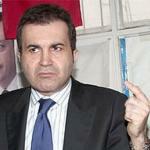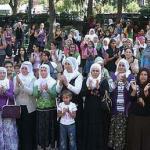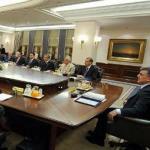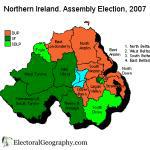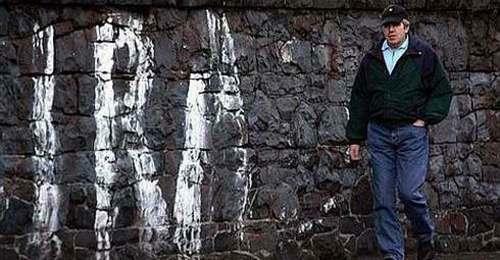This is the second part of political scientist Dr. Zafer Yörük's evaluation of the peace processes in Northern Ireland and Turkey. Click here for the first part on the peace process in Northern Ireland.
If one divides the peace process in Ireland into three main components, this helps to compare it with a possible peace process in Turkey.
1. Relations between political actors:
a. As I indicated in the first part, the problem in Northern Ireland was a conflict with historical roots between two societies living in the same region. What is important as regards a peaceful solution to the "Kurdish question" is that there was never such regional conflict. In fact, apart from the losses on both sides, there have been no serious ethnic tensions in Turkey generally during these 25 years of conflict, despite the extreme chauvenist agitation of the Turkish press and media. (As the Prime Minister emphasised, the fact that there was no important religious division, such as between Catholics and Protestants, has been important).
b. It is possible to see similarities between Sinn Féin and the Democratic Society Party (DTP), which the Turkish state is speaking to. The DTP seems to have the ability to use its authority as the elected representatives of the Kurdish movement in Turkey, which includes the PKK. However, one must keep in mind that there is not exactly the same organic relation between the DTP and the PKK as there was between Sinn Féin and the IRA. Despite the claims of the Constitutional Court, which is still considering the indictment to close the DTP, and which has closed other parties, from HEP to DEHAP, the DTP is not a structure designed to be the legal representative fo the PKK. That is why it has to be remembered that the DTP and the PKK are separate actors, and that the DTP will take on a kind of "indirect representation".
c. There are important similarities between the Turkey of today and the Britain of before 1994. In particular, Margaret Thatcher had obstructed the peace process by insisting that the IRA lay down arms before she would meet with any Northern Irish representatives. It was later realised that this was not realistic; when the British state began to consider this as the aim of the peace talks rather than a precondition, the peace process was rescued. That is why the condition of demanding the surrender of PKK guerillas for a solution of the "southeastern question" may be reconsidered.
d. The main weakness in our comparison is the fact that the Kurdish side seems to form a whole, while the side of Turkey is divided. However, the similarity between the discourses of (CHP leader) Deniz Baykal and (MHP leader) Devlet Bahçeli and the discourse of Ian Paisley, who called negotiations with "terrorists" "high treason", are striking nonetheless.
It has to be added here that the opposition leaders in Turkey are not only speaking for their base, but also for important elements of the state. Undoubtedly the most important of these is the General Staff. However much the General Staff may have said that the army has done its duty and that it is now time for political prevention, we must not forget that Chief of General Staff İlker Başbuğ said in one of his last press briefings that he considered this "political and psychological prevention" to mean "founding rehabilitation centres for regretful terrorists". Under these conditions, the protests of the opposition leaders must be read as a symbol of the long way that has to be gone until the military-bureaucratic elite becomes convinced of taking part in real peace. As long as the state cannot manage to achieve agreement between different parts and make Kurdish peace a state policy, it will face many more difficulties as compared to the Britain-Northern Ireland peace process.
e. The restoration of Kurdish names for villages, districts and regions that were forced to undergo Turkification at different times of the republican history and a decrease in the oppression that continued despite the lifting of bans on Kurdish publications and education are "gestures" that should not be underestimated. Again, an important element of the Northern Ireland peace process was the release of hundreds of IRA militants from prison. Today, an amnesty that targets Kurdish prisoners is becoming increasinly vital. Another gesture was an end to the use of the name "Ulster" in official British documents. It is to be hoped that Turkey can also give up the code name "southeast" and use the region's real name.
2. Participation of outside mediators
US Senator George Mitchell played a vital role in the Irish peace process. The same Mitchell is today Barack Obama's special Middle East representative. In addition, Mitchell had visited Turkey a week before President Abdullah Gül made the historical statement that "there is an important opportunity for peace" and it can be seen as meaningful that he had met with both Gül and Prime Minister Erdoğan. The meeting of Bill Clinton and Gerry Adams in the White House in 1995 became a symbol of the US desire for peace. A very similar symbolism can be seen in the announcement by the DTP that it is opening an office in the USA after DTP leader Ahmet Türk met with the US Ambassador last week. In this way, if only indirectly, the US has announced its support for a peace process. This leads us to predict that soon the US may participate even more, in the role of an outside mediator.
3. Role of regional powers:
One of the most important participants of the Northern Ireland peace process was the (southern) Irish Republic. There is an important similarity between this relation and the geographic position of the Kurdistan Regional Government in the south, as well as close family relations between the Kurds of Turkey and the Kırmanci population of the Kurdistan Autonomous Region. Undoubtedly, the domestic peace of Turkey is of interest to all countries in the region, but it is correct to assume that the Kurdistan government will take on an important role among the regional powers.
Conclusions: Putting out fires or the destination of the journey
Dostoyevsky said about anarchists burning down a village: "The fire is not in the roofs of the houses, but in people's heads."
Today the British state, the Northern Irish Republican movement, and the Catholic and Protestant communities live together in harmony and have arrived at workable institutions, despite the fact that they were in conflict until not long ago. The most important contribution to the peace process was the putting out of "fires in the heads" on all four sides.
In Turkey today, groups supporting peace are increasingly optimistic about expecting the PKK to lay down arms immediately, while the other side is fuelling nightmares about Turkey being divided and the "southeast" of the country going to be united with "Northern Iraq" in a "Greater Kurdistan State".
Those supporting peace suggest the "Scottish model" or the "Algeria model", while the other side is talking of a lack of solution in the "Peru" or "Sri Lanka model".
However, a peace process needs a long period of negotiation; in Northern Ireland, they took 13 years. Sides in a peace process do not sit down at the table with speculations about a definite outcome; rather, they sit down with concrete demands, and step by step, they may come to a point that cannot be predicted today. That is why this analysis does not suggest the use of a "Northern Ireland model"; rather, it describes the course of a peace process. In many journeys, the journey is more important than the destination.
However, if we cannot resist a focus on the target to be achieved, let us emphasise this: beyond all speculation, a valid target all on its own is the end to bloodshed, or, in Dostoyevsky's words, the putting out of "fires in the heads".
The most important expection from a Kurdish peace process would be to control, if not to put out the "fires in our heads" that have constantly been fanned by decades of chauvinism; perhaps then the "real fire" that has been blazing on the roofs of a people for a hundred years can die down. (ZY/EÜ/AG)
* Dr. Zafer Yörük, political scientist at Essex and London University. He worked in Arbil, Northern Iraq, in 2007.







